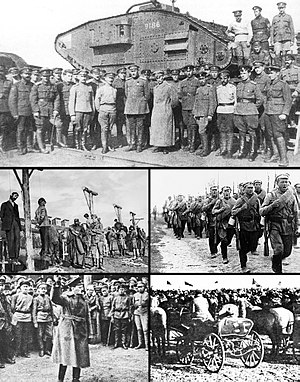The two largest combatant groups were the Red Army, fighting for the Bolshevik form of socialism led by Vladimir Lenin, and the loosely allied forces known as the White Army, which included diverse interests favoring monarchism, capitalism and alternative forms of socialism, each with democratic and antidemocratic variants. In addition, rival militant socialists and nonideological Green armies fought against both the Bolsheviks and the Whites. Eight foreign nations intervened against the Red Army, notably the Allied Forces and the pro-German armies.
The Red Army defeated the White Armed Forces of South Russia in Ukraine and the army led by Admiral Aleksandr Kolchak in Siberia in 1919. The remains of the White forces commanded by Pyotr Nikolayevich Wrangel were beaten in Crimea and evacuated in late 1920. Lesser battles of the war continued on the periphery for two more years, and minor skirmishes with the remnants of the White forces in the Far East continued well into 1923.
| Russian Civil War | ||||||||||
|---|---|---|---|---|---|---|---|---|---|---|
 Clockwise from top: Soldiers of the Don Army in 1919; a White infantry division in March 1920; soldiers of the 1st Cavalry Army; Leon Trotsky in 1918; hanging of workers in Yekaterinoslav by the Austro-Hungarian Army, April 1918. | ||||||||||
| ||||||||||
| Belligerents | ||||||||||
Ukrainian Soviet Socialist Republic (20 November 1917–30 December 1922)
|
Allied Intervention
Pro-German armies
|
Other Factions
Various anti-soviet factions also fought among each other. | ||||||||
| Commanders and leaders | ||||||||||
|
| ||||||||||
| Strength | ||||||||||
3,000,000
103,000 Revolutionary Insurrectionary Army of Ukraine | 2,400,000 White Russians | |||||||||
| Casualties and losses | ||||||||||
| ~1,500,000 259,213 killed 60,059 missing 616,605 died of disease/wounds 3,878 died in accidents/suicides 548,857 wounded/frostbitten | At least 1,500,000 | |||||||||
Armed national resistance in Central Asia was not completely crushed until 1934. There were an estimated 7,000,000 –12,000,000 casualties during the war, mostly civilians. The Russian Civil War has been described by some as the greatest national catastrophe that Europe had yet seen.
Many pro-independence movements emerged after the break-up of the Russian Empire and fought in the war. Several parts of the former Russian Empire - Finland, Estonia, Latvia, Lithuania, and Poland - were established as sovereign states, with their own civil wars and wars of independence. The rest of the former Russian Empire was consolidated into the Soviet Union shortly afterwards.
Many pro-independence movements emerged after the break-up of the Russian Empire and fought in the war. Several parts of the former Russian Empire - Finland, Estonia, Latvia, Lithuania, and Poland - were established as sovereign states, with their own civil wars and wars of independence. The rest of the former Russian Empire was consolidated into the Soviet Union shortly afterwards.
Ei kommentteja:
Lähetä kommentti
Any explosive ammunition or empty cores, you can put in this.